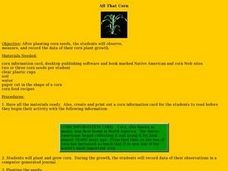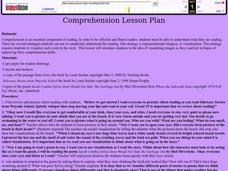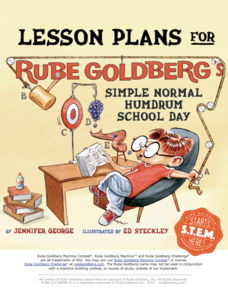Curated OER
Symbols That Represent Me
In this self-evaluation worksheet, students write about their personality traits, what they like, and their hobbies and then illustrate symbols to represent their answers. Students complete 2 activities.
Curated OER
Reach for the Stars
Students investigate the Underground Railroad. In this slavery instructional activity, students read books about slavery, the Undeground Railroad, and how slaves escaped the south. Students develop knowledge about coded songs and...
Curated OER
All That Corn
Students observe and record data. In this plant growth lesson, students plant and grow corn. Students observe the growth of their corn and record their data. Students read corn recipes and select their favorite four recipes to write...
Curated OER
Sahara Special
Third graders read the book Sahara Special and participate in comprehension activities. In this realistic fiction lesson, 3rd graders create a brochure for where they live. Students have personal bags, a brown paper bag, that they fill...
Curated OER
Studying the ABC's of the Environment
Third graders choose a letter of the alphabet and find an environmental topic to research that begins with the same letter. They prepare an article and illustration about their topic and compile them into a class environmental alphabet...
Curated OER
Visual Sum and Difference Word Problems - Independent Practice
The ten prompts on this worksheet are intended for independent practice with addition and subtraction of numbers up to 3000. Space is provided for pupils to illustrate their work. The confusing wording of some the problems would be a...
Curated OER
Diary of a Fly, Diary of a Worm, Diary of a Spider
Students read the books Diary of a Fly, Diary of a Worm, and Diary of a Spider and write diary entries about them. In this reading lesson plan, students also draw pictures to go along with their diary entries.
Curated OER
Walk on the Wild Side
Have your class practice alliteration using this activity. Learners listen to stories with alliterative elements and create their own sentences illustrating this technique. The activity is incomplete, but could be enhanced to provide a...
Curated OER
The Four Freedoms
Students discuss the four freedoms. In this freedom lesson, students discuss freedom of speech, freedom to worship any God, freedom from want, and freedom from fear. They create a picture to match each freedom and make a book shaped like...
Curated OER
Comprehension
Students identify that comprehension is an essential component or reading and in order to be efficient and fluent readers. They interpret what they have read through various strategies. Finally, students use one of the strategies,...
Curated OER
Endangered Animals
Introduce young learners to endangered animals. They write a report of an endangered animal and create an illustration for their report. They create a poster for their report as well and present it to the class.
ReadWriteThink
Teaching Point of View With Two Bad Ants
What better way to explain the concept of point of view than from an ant's perspective! After reading Two Bad Ants, pupils identify the point of view of the ants by studying the text and pictures. Then, they fill out a chart that...
Roald Dahl
Matilda - Miss Honey and The Trunchbull
As the instructor reads aloud several quotes from five chapters of the story Matilda, class members mime their interpretation of the scenes. Then, after reading "Miss Honey" and "The Trenchbull" (chapters seven and eight), the class...
Roald Dahl
Matilda - The New Home
Matilda finally gets her happy ending with a new home with Miss Honey. But first, Mr. Wormwood goes on trial for his wrong doings and bad car sales. Class members take on the role of a character in the trial and participate in a role...
Curated OER
The Magic Opera
Introduce your young learners to opera by dressing up as Mozart and recounting some of the fascinating details of his life and music. After exploring the Metropolitan Opera's site for kids, the class listens to a reading of Kyra...
Roald Dahl
Matilda - Throwing the Hammer
Full truth, or an exaggeration? How can you tell when a storyteller is exaggerating a story? Readers analyze a story told by Hortensia, and identify the exaggerative language she uses. Then, learners write their own narrative story using...
Museum of Disability
Taking Visual Impairment to School
What is the world like when you can't see, or when your vision is impaired? Learn about how Lisa communicates with the world around her with Taking Visual Impairment to School by Rita Whitman Steingold. Learners answer discussion...
Rube Goldberg
Rube Goldberg's Simple Normal Humdrum School Day
If you're going to build a machine, you might as well make it interesting and amusing. A set of eight lessons and activities introduces simple machines using Rube Goldberg machines. A culminating project challenges techies to create and...
United K12
Jan Brett Author Study
Expose young children to the wonderful works of author and illustrator Jan Brett using a few of her stories such as Armadillo Rodeo, The Mitten, or Daisy Comes Home through a unit study.
National Science Teachers Association
Hop into Action
Young scientists find out what makes amphibians such unique and interesting animals in this simple life science activity. After looking at pictures and discussing the characteristics of amphibians, learners complete a series of three...
Fun Music Company
Intervals
As part of their study of intervals, musicians are asked to draw the interval indicated above the notes provided on the worksheet.
Fun Music Company
The Harmonic Minor Scale
The harmonic minor scale, including the use of accidentals, is the focus of a one-page worksheet that includes instructional information and practice exercises.
Fun Music Company
Relative Major and Minor
It's all relative. Young music theorists are asked to count to three and identify the relative major and minor keys of keys that share the same signature.
Curated OER
Amos and Boris: Text Study
Twenty insightful questions follow a read aloud of the story, Amos and Boris by William Steig. Scholars then show what they know through completion of a cause and effect chart, reading fluency assessment, and a written explanatory or...

























